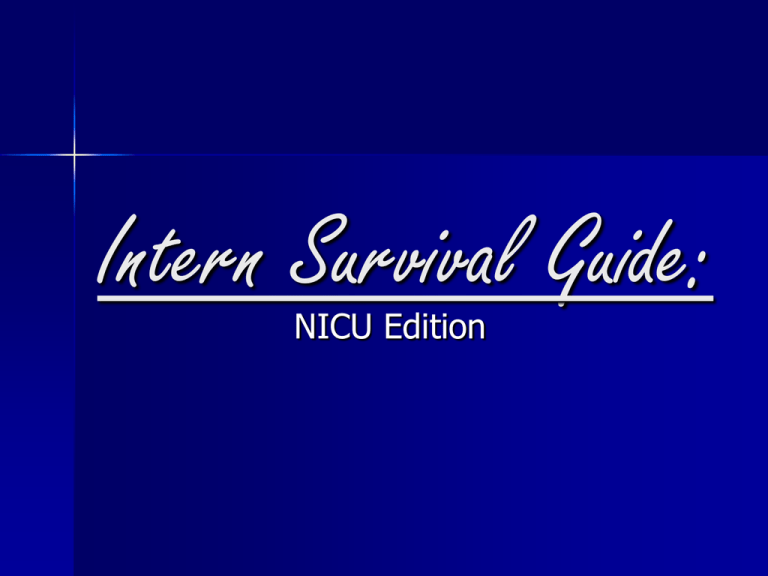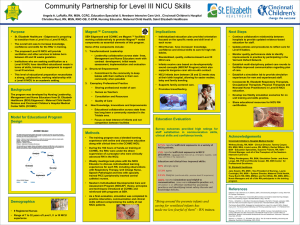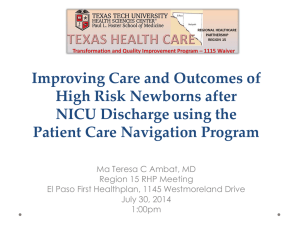Intern Survival Guide: NICU
advertisement

Intern Survival Guide: NICU Edition Outline Introduction Schedules Prep work Division of labor Where things are When things happen Crunching numbers Rounding with the attending IHI Orders Med Rounding The DR/OR and Admissions Progress notes and Updating the list Discharges Signing Out Call 2 So you’re starting NICU… NICU is located on 8S – hang a right from the elevators. The resident call room is across from the entrance. The code is 145 and the door sticks. Keep trying. No one locked you out. We promise. Scrubs are cool to wear every day, but if you’re wearing long sleeves under your scrub top, make sure you can push them above your elbows easily. No eating or drinking at all on the unit. There’s a break room to the left when you walk in and a fridge in the call room. 3 Scheduling If there are only three residents on for the block, you will follow a Q3 schedule. If there are four residents on, you can decide amongst yourselves if you want to be Q4 or have a nightfloat week (one week sun night through thurs night, plus one additional 24 Friday and 24 Saturday). Make sure to email the chiefs in advance to let them know. There is no scheduled continuity clinic during the NICU month. The resident on call will be the designated “labor and delivery” person and given the resident baby-baby pager each day. That resident is the one who will go to all the deliveries, so stay on your toes. 4 Schedule Access To access your personal schedule, go to: – New Innovations: https://rms1.newinnov.com/Login/Login.aspx – After logging in, hit – View: Take a couple of hours one day and just browse through new innovations. It does take some getting used to. 5 Preparation If it’s July and NICU is your first rotation, you’ll have a nice orientation during orientation week and you can get sign-out from the departing intern then. If it’s not July, the day before the rotation starts, make your way up to the NICU and get sign-out from one of the interns. If they’re really nice, they’ll show you around and teach you how to do numbers. If not, or if you’re still confused, just continue reading this presentation. 6 Division of Labor NICU patients are divided into three teams, first by color (red and green) and then by covering practitioner (resident or NP). There is no NP on the red team. The NNPs are amazing so be really nice to them… I’ve heard they like chocolate. When you’re on call at night and over the weekend, you’re responsible for all the resident babies, red and green. It’s hard to know all of the opposite team’s patients very well, since you don’t round on them daily, but try to pay close attention to the history and management of the patients on your own team, even if they’re technically not “your patients.” It really helps. 7 Where Things Are: The Binders The big yellow (red team) and blue (green team) binders will be your team’s filing cabinet. Here is an overview of what’s inside: – Yellow binder only: Rounding information Tips, tricks and Suzanne’s “So you’re starting NICU” document, also posted on fellinahole Dictation template – Blank daily flowsheets and progress notes – Admission face sheets and H&P (for admission and discharge) forms – Ballard scoring (front) with growth curves (back) – Current patient information separated neatly by handmade dividers (using sticker pages). – Recently discharged patient information – we keep them 8 for a few days. Where Things Are: Bedside Charts There are a couple things that are important to you in the thin, blue bedside chart: – Apnea/Brady log (usually right at the front.) – IHI (we’ll get back to this later) If you take a bedside chart out of a room, tell the nurse. Even better, ask that nurse if he or she minds that you take it. They’ll appreciate the consideration. 9 Where Things Are: Big Red Charts The big red charts sit behind the clerk. Things that will there that are important to you: – Progress notes – Consults – Admission paperwork (after it’s done) – DR/OR summary (in the OR section) – Outside institution/lab information All charts are thinned once a week. Old charts can be found in the big filing cabinets where the printer is, behind the clerk’s desk. 10 Where Things Are: Consents Mom is the consenting parental unit always unless there is a CPS issue. Dad can never give consent. There are a bunch you should get when the baby is first admitted: – NICU – give permission to be in the NICU – JHACO – acknowledges we gave her info on privacy – HepB – if baby is >2kg. – Circ – if mom is interested. They will either be clipped in the blue chart (usually when patient is first admitted) or in the “consent” section of the red chart. If the consents are in neither of those places, just ask the clerk to print them out for you. If you don’t get the consents right away, it’s fine. Moms will usually visit when they recover, before they make the crosscountry trek to mother-baby. If they don’t, just grab the forms and head over to L&D. Moms will want to know about what’s 11 going on anyway, so it’s good chance to update them/ask questions/get consents signed. Where Things Are: Daily Sign-Out The first computer right as you walk in is our resident computer. Here you can find the hard drive with the sign-outs… but only if you have access. Make sure to e-mail Peter Vecere and ask him for UHMC Peds Access. This will give you access to floor sign-outs, too. The pediatrics drive is on the desktop. The most recent sign-out will be in the “NICU” folder. 12 Where Things Are: Misc Optho Book – On top of the cabinet that houses the green team red charts. Extra stickers – Big Red Charts – Thin Blue Charts – “Red” or “Green” (literally labeled as such) clerk’s binder, usually on the inside left corner of the desk. – In the large reservoir of what clerks can print for you. I’ve heard they like chocolate. Linens – To the left, on the way out of the NICU by room 114. Med room – code is 2001. Ophthalmoscope – Usually in the med room. Vaccine Information Sheets (VIS) – Lower right 13 desk drawer in front of room 112. When Things Happen Weekly Labs (H&H, retic) – Order on Tuesday for AM Wednesday Weekly length, head circumference – Order on Tuesday for AM Wednesday – Don’t forget to plot these! Optho exams – Wednesday Fluid, drip, TPN renewal – Every day 14 When Things Happen TPN TPN must be ordered before 11 every day. Fellows like to order TPN before rounding, so try to catch them so you can do it together. For more information on formulas and other things to know when ordering TPN, review the NICU manual @ http://www.fellinahole.com/chartdata/nicu/tpn. html 15 A Day in the Life 7am is the usual designated start time. Throw your things in the call room and come on in. You should pull your sleeves up and scrub, surgical style, at the big sink when you get here. Find the resident who was on call and get sign-out from the night before. That should include all labs and films that were designated for the AM, which makes your life a LOT easier. The most senior resident on your team will distribute the overnight admissions – don’t forget to get vitals on the new admission, too. All Is and Os are computerized now, so find one and start your numbers. 16 Crunching Numbers Your most important job in the morning is to get the “numbers” on all of your patients. For the first week of life (days 1 through 7), all numbers are based on birth weight. Starting day 8, you can use actual weight. 17 Crunching more numbers… It’s important to keep meds and levels updated. Be sure, even if your kid has been off caffeine for a week, a covering attending will want to know the last caffeine level. You don’t have to list ALL of the result as you make sheets, just the most recent. The last big box is for the plan, which you can scribble in on rounds. (We’ll get to rounds later.) 18 Back to crunching numbers… Little kids need fluids. Their total fluids will vary with their gestational age and issues. Most kids will either start with 100cc/kg/day (little kids) or 80cc/kg/day (bigger) and we’ll work up from there. You care about two things – 1. How many cc/kg/day the baby is getting – 2. How many kilocals/kg/day the baby is getting Kids get fluids in 2 ways: parenteral and enteral. Enteral is easy so we’ll do that first. 19 Calculating PO fluids Total fluid volume cc/kg/day = total ccs PO weight in kg Total calories The number designation of formula (E20, S24) denotes how many kcals per ounce a formula has. You don’t really care about ounces, though. You want ccs. And there are 30cc to an ounce. Therefore the general rule is that: kcals in formula = kcals/cc 30cc It then follows that: Hints, tips and tricks • rice is 1 kcal/cc • breast milk is 20kcal/30cc or 0.67kcal/cc kcals/kg/day = kcals/cc x total cc PO weight in kg 20 Our running total PO cc/kg/day kcal/kg/day PE24 (215cc) / 1.85kg = 116 (215cc)(0.8) / 1.85kg = 93 116 93 CHO Protein Lipids Other Total 21 TPN: Dextrose Total fluid volume cc/kg/day = total cc TPN weight in kg Total calories • First you need to figure out how many kcals per cc your dextrose is giving you. This formula is true for all formulations of TPN: (% dextrose)(3.4) = kcals/cc 100 Hints, tips and tricks • Lipids don’t count in the total volume of TPN (they run in their own bag) but protein does! Therefore, protein adds additional calories without adding additional fluid. kcals/kg/day = (kcals/cc)(cc TPN) weight in kg 22 Our running total cc/kg/day kcal/kg/day PO PE24 (215cc) / 1.85kg = 116 (215cc)(0.8) / 1.85kg = 93 CHO D10 (81.8cc) / 1.85kg = 44 (81.8cc)(0.34) / 1.85kg = 15 160 108 Protein Lipids Other Total 23 TPN: Protein Total fluid volume 0 Total calories • First you need to go to the TPN bag itself and note two things: order volume and trophamine (protein). • Amount of protein is dependent on how much is in the bag and how much of the bag the baby got. Kcals/kg/day = Trophamine x total cc TPN x order volume 4 weight in kg 24 Our running total cc/kg/day kcal/kg/day PO PE24 (215cc) / 1.85kg = 116 (215cc)(0.8) / 1.85kg = 93 CHO D10 (81.8cc) / 1.85kg = 44 (81.8cc)(0.34) / 1.85kg = 15 0 (14/500) x 81.8 x (4/1.85) = Protein 5 Lipids Other Total 160 113 25 TPN: Lipids Total fluid volume cc/kg/day = total cc lipids weight in kg Total calories • First you need to figure out how many kcals per cc your lipids are giving you. This formula is simply: kcals/kg/day = (2)(cc of lipids) weight in kg 26 Our running total cc/kg/day kcal/kg/day PO PE24 (215cc) / 1.85kg = 116 (215cc)(0.8) / 1.85kg = 93 CHO D10 (81.8cc) / 1.85kg = 44 (81.8cc)(0.34) / 1.85kg = 15 0 (14/500) x 81.8 x (4/1.85) = Protein Lipids 5 IL (44cc) / 1.85 kg = 22 (44cc)(2) / 1.85kg = 46 Other Total 183 159 27 Numbers: Other Anything dripping in (morphine, sodium acetate, etc.) counts for cc/kg/day but provides no calories. Anything being put out (ie OG, repogel) must be subtracted from cc/kg/day For those who are a little more high-tech, check out the NICU calculator (peds drive NICU folder NICU documents.) 28 Rounding with the Attending It’s usually attending dependent, but expect to round every day at around 9am. (Dr. Shah is the exception – he rounds early and fast, so stay on your toes!) Attendings will either round with residents and NNPs altogether or separately. It varies from attending to attending and day to day. Verbal presentations follow the flow sheet exactly: – One liner on history – “Ex 331/7-weeker with resolving RDS, status post ROS.” – DOL, weight, and weight change – What the baby is feeding (PE24), how much (27.5-30cc), how often (Q3H) and route (nipple vs. NG tube). – Then just read off the remaining columns (cc/kg/day, kcal/kg/day, UOP, stools) all the way to As/Bs. – A good order for the rest is meds new labs new films/other studies other changes made the day before any new developments. 29 – As the plan is discussed, write it in the lower right box. IHI/Daily Goals While you’re presenting, another resident (or the fellow) will get the “IHI” form – NICU daily goals and plan of care – from it’s section in the thin blue bedside chart. Nurses fill out the left side, it’s our job to fill out the right side. Everyone present at the bedside should sign the form on page 2. There is an “IHI fellow” who will round on patients under 1500g. The nurses read off the IHI and a more in-depth interdisciplinary discussion takes place. Formal “IHI rounds” usually happen before attending rounds. You should attend if the IHI rounds are happening on one of your patients. 30 Orders During rounds, while you’re presenting, another resident (or fellow) will usually put in orders for you depending on what is being discussed. Don’t forget to come back and check to make sure those orders were actually picked up. People get busy. Even though orders are written on the computer, you have to show all (virtual) math. When ordering Zantac, you should pick the “2mg/kg” option so the computer does the math for you. Zantac (2mg/kg/day)(1.04kg) = 2.08; round to 2mg PO Qday. Every time TPN is sent from pharmacy (usually 3 in the afternoon every day) you’ll need to set a rate. Make sure to tell a nurse when you’ve written an order. It should pop up on her task list but you never know. 31 Order Rewrites CPOE makes order rewrites obsolete. However, it is prudent and necessary to check every order every day to make sure that you haven’t hit a soft stop and it hasn’t fallen off of the nurse’s MAR. Compare active orders to what the patient should be getting to exactly what the patient is getting (MAR) every day. 32 Med Rounding The NICU has standardized drug dosing by instituting rounding policies on specific drugs. These are also found in the front of red team’s yellow binder. Highlighted drugs are very commonly prescribed, so if you’re going to remember any off the cuff, it’s these. Adapted from NICU Manual, Annie Rohan, NNP 33 The Delivery Room and Operating Room Go to lots of deliveries. You’ll learn a lot and staff is very eager to each. At first, you’ll attend all deliveries with someone more experienced – a fellow or an NP. After attending three, you’re certified to go to uncomplicated deliveries alone (just you and the DR nurse). However, if you’re uncomfortable attending a delivery by yourself, someone will always be there to go with you. You’re never truly alone. You’ll never go to complicated deliveries on your own. When you go to the OR and you’re the one catching the baby, you’ll have to scrub in surgical style. Don’t forget your hat and mask. 34 Responsibilities in the DR/OR The attendings, NPs and fellows will go over DR/OR proceedings in more depth. However, be aware that your primary role is airway – which puts you at the head of the radiant warmer. Review your neonatal resuscitation handbook – it helps. You also will need to assign the APGAR score and write a very brief note in the birth report detailing why you were called and what kind of resuscitation took place (even if it was only stimulation and bulb suction.) If the baby comes back to the NICU with you, take the yellow copy of the birth report. If the baby goes to newborn, you don’t have to take anything back with you. 35 NICU Admission Criteria From from NICU Manual, Kathy Gilsbach, RN, MS The following babies must be admitted to NICU: Babies less than 351/7 weeks as documented on the yellow 'Birth Record' and less than 2000 gms. These babies must come to the NICU for a period of observation to ensure normal transition. Infants >35 weeks have no specific length of time they must stay in the NICU. In general the transition period should be no less than 4 hours. Infants <35 weeks must stay for a minimum of 24 hours of cardiopulmonary monitoring. Any baby who shows signs of delayed transition/physiologic instability, including tachypnea, grunting, flaring, etc., should come to NICU for observation and monitoring, but as above, do not have to stay once normal transition is ensured. Keep in mind that normal newborn nursery has limited ability to monitor babies, both in terms of equipment and staff. 5 minute APGAR < 6 Hypoglycemia Maternal temp >100.4 and/or any documented diagnosis of chorioamnionitis Infants who receive naloxone (Narcan) at delivery (for 24 hrs of 36 monitoring) NICU Admission Orders When a baby is admitted to the NICU, after he or she is stabilized, the most important thing to do is write the admission orders – now made super simple with CPOE’s power plans. Pick the one that fits your patient the best (“Full term infant with congenital heart disease”) and all you have to do is check what you want. One of the fellows or one of the fabulous respiratory therapists will be on hand to show you how they like to do respiratory orders. For every change in vent settings or mode of support, you’ll have to write a new order. Unlike on the floor, residents don’t write an admission note. The fellow will take care of that. However, that 37 doesn’t mean you don’t have work to do. Admission Paperwork: Important Info to Know Maternal History – Mom’s chart/Mom herself (best) – The CIS system The computer closest to the clinicians room with the rolly mouse is the CIS computer. Your login is whatever you use to check your mail (ie LSmith) and the password is “baby.” Select the mom that you’re interested in and surf around to see what you can find. It will, at the very least, have her age, her parity notation and her prenatal labs. How to: security login select a patient – Powerchart/Eclipsys Birth History – Birth report – yellow copy Vitals – The Nurses’ Admission packet will detail the initial vitals and their physical. Blood Type/Antibody Information – Cord Blood pH – Mom’s Powerchart under “Last 48 hours” tab – Baby’s blood type/antibody – Baby’s Powerchart ONLY if cord blood 38is released Admission Paperwork: Your Arsenal The following goes into the appropriate team’s binder: – Divider: Take a sheet of stickers and make a divider. – Facesheet – Flowsheet – Ballard Score and Growth Chart – Initial Physical Attending must sign this Add the new patient to the appropriate team list. Don’t forget to consent the mom. 39 The Daily Grind: Progress Notes and Updating the List Progress Notes – There are post-call days, lecture days, etc. that make note-writing difficult, but do the best you can. – Examine your babies every day regardless of how busy it is. Try to coordinate your exam with “handson” nursing so you don’t disturb the baby too much. Updating the list – If you’re not the person on call, you should update the list before you leave. A good habit to have is to update the list twice – once after rounds and once before you leave. – If you’re the person on call, you’ll end up updating the list a hundred times. It’s inevitable. 40 Discharge Checklist Discharge Summary In thin blue bedside chart or have the clerk print one Fill in all pertinent info and all newborn screens done (not just the most recent) Fill in ALL follow-up appointments with the name of the physician, phone number and time-frame. Attendings must sign the bottom Discharge Physical Same form as admission physical, just circle “discharge” on top. No need to fill out the history section again, just cross it out and write “see admission physical.” Once again, check for a red reflex and have the attending sign at the bottom. The pediatricians appreciate a heads up about the patients before they are seen. Call the PMD and give a brief history. Write the dictation confirmation number on the facesheet Move the patient’s paperwork from the “admission” section of your binder to the “discharge” section. Remove the patient from the list. Informing the PMD Discharge Orders Dictation and Beyond 41 Signing Out If you’re not on call, you should be able to sign out to the on-call resident as early as 3pm, as long as all your work is done and there’s nothing else going on. Update the list and give the on-call resident a copy. Make sure to sign-out anything pending overnight and for the AM. If the on-call resident is on a different team, it’s probably prudent to give a little background on your patients, especially new ones (admitted in the last 3 days). There is no “formal” sign out. Just find the on-call resident and ask if he or she minds you signing out. Remember to also sign out your patients to a 42 teammate before you leave for clinic. Call: Weeknights Weeknights – You’re in charge of all the red and green resident babies from sign-out until 7am the next morning. – There will be an attending, an NNP and a fellow on with you at night. However, you’re first in line if there’s an issue with a resident baby – the call will come to you. – You and the NNP will alternate delivery and admission responsibilities. – You should wake up early enough in the morning to get all of the pending labs, update the list and do all of your numbers before the rest of the team gets there at 7am. 43 Call: Weekends Friday – Same as weeknights, except before signing out to the resident on Saturday morning, you should do all the numbers for every patient on your team. Saturday – Saturday is the most labor intensive day. – Saturday morning, you’ll have to do the numbers for the patients that the Friday night resident didn’t take care of. – Then, on Sunday morning, you should do the numbers for every patient on your team, as well as getting the labs, updating the list, etc. Sunday – Sunday morning numbers for patients the Saturday resident didn’t do. – Monday morning, you can just do your own patients’ numbers. 44




